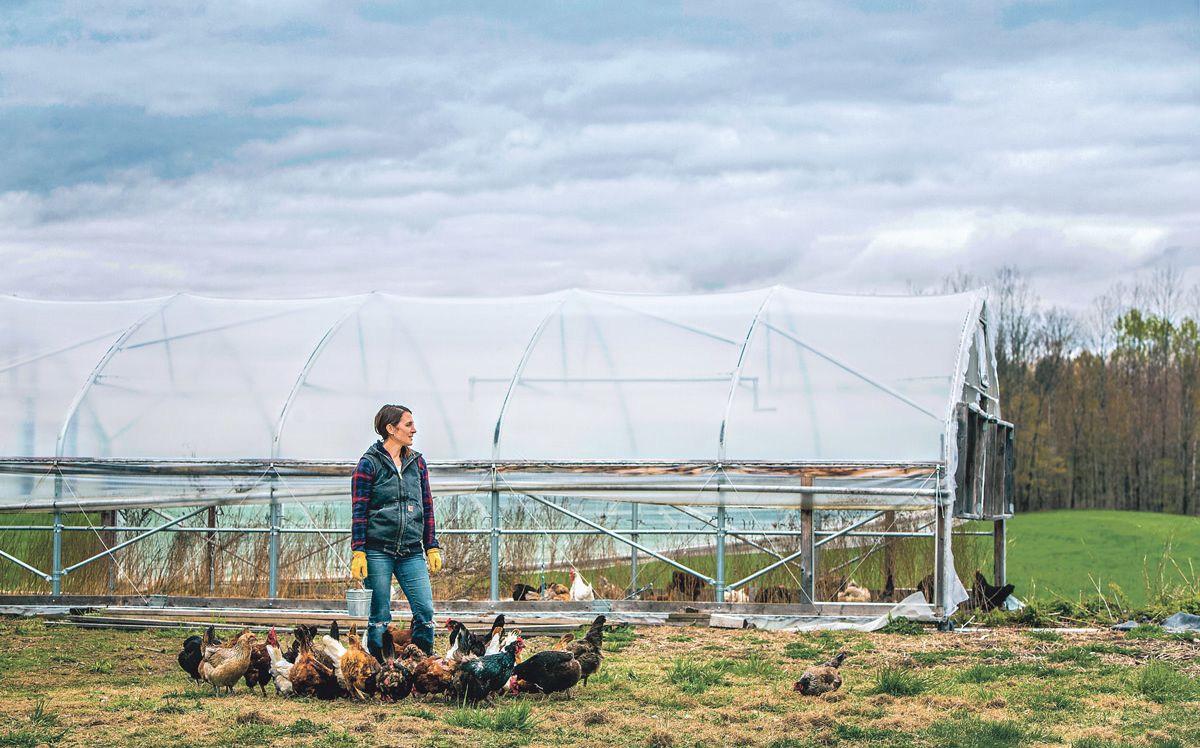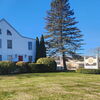
Processing Your Payment
Please do not leave this page until complete. This can take a few moments.
- News
-
Editions
View Digital Editions
Biweekly Issues
- December 1, 2025
- Nov. 17, 2025
- November 03, 2025
- October 20, 2025
- October 6, 2025
- September 22, 2025
- + More
Special Editions
- Lists
- Viewpoints
-
Our Events
Event Info
Award Honorees
- Calendar
- Biz Marketplace
Auburn agriculture zone changes spark debate over what's the best way forward
 Photo / Tim Greenway
Auburn farmer Karen Bolduc feeds some of her 100 laying hens on her farm. She envisions the city as a place where farmers can thrive, adding to the regional economy.
Photo / Tim Greenway
Auburn farmer Karen Bolduc feeds some of her 100 laying hens on her farm. She envisions the city as a place where farmers can thrive, adding to the regional economy.
Karen Bolduc envisions an Auburn where farmers can thrive, adding to a strong city and regional economy.
The farms would do business with each other, as many of the region’s farms already do, as well as with supporting businesses.
“This is how local economies work,” she says, as she tends to a vegetable patch at her farm.
Auburn Mayor Jason Levesque says he has a similar vision.
“We need more farming industry in Auburn,” he says. “Some of these small farms can go bigger, there can be spinoffs, industrial multipliers.”
How to get there, though, is a different story.
As Auburn struggles to revise its 55-year-old Agricultural and Resource Protection Zoning District, Bolduc and Levesque are two voices among many battling over how that new economy will be formed.
Too restrictive for growth
The zone, set up in 1964, comprises more than 20,000 acres — 40% of the city’s land mass. It requires that a property owner must derive 50% of income from farming, and the lot be at least 10 acres, to build a home on the property.
A committee formed by Levesque last fall has recommended the income requirement be reduced to $1,000 a year, or $1,000 investment in agriculture. The 10-acre minimum would be lowered to three.
That committee is the second to study the topic. The first one, formed in 2017 under then-mayor Jonathan LaBonte, reviewed conclusions from a $50,000 study of the zone and its impact on the regional economy by Crossroads Resource Center, of Minneapolis.
The study, published in early 2018, determined that the zone has been effective at keeping land prices low and limiting development, but, by itself, does not foster a strong agriculture sector. It said a key influence will be city policy decisions, investments in infrastructure and marketing.
“If Auburn does not invest in agriculture, there is a significant threat that farms will go away,” it said.
After the report was completed in early 2018, the first committee recommended:
- A permanent committee be set up to advise the city council on policy development and implementation of agricultural, forestry and resource protection initiatives;
- The 50% income rule be replaced with “a fully analyzed, researched and targeted alternative that will serve long-term goals and priorities” for the zone and economic sector.
Almost everyone involved agrees the 50% agricultural income requirement is archaic — on many farms, someone works outside the home at a job that’s more lucrative than the farm.
In fact the zone is so restrictive, it’s shut out new farmers, Julia Harper, coordinator of the Good Food Council of Lewiston-Auburn, told a March conference on energizing the local food economy.
But the $1,000 minimum alternative and Levesque’s resistance to a permanent advisory panel are flashpoints in a divisive debate over how the city should approach agriculture.
Valuable turf at center of battle
The turf battle revolves around some of the richest farming soil in Maine, a result of the Androscoggin River dredging a winding path through the valley over centuries, leaving behind fertile alluvial soil.
The city’s southern third, almost entirely zoned for agriculture, is 30 minutes from Portland, which positions it as a supplier to the restaurant and local food focus in Maine’s biggest city.
While farming in Maine is decreasing, there is an increase in farmers under 34, and it’s one of the largest sectors of people moving to the state, the Maine Farmland Trust reports.
The number of New American farmers, many of them members of the Somali-Bantu Community Association, is also growing. The association farms 13 acres in Lewiston, with 130 farmers each on one-tenth of an acre, says Abby Sadauckas of Land for Good, which works with the association. The group is looking for more land as it increases its business reach.
“This land has an incredible story to tell,” Harper said at the March conference. “Current efforts to craft a new ordinance have potential to make it attractive to a growing population of young farmers and food entrepreneurs.”

‘Farmers want to farm’
Bolduc, a Raymond native, bought the Auburn farm with her husband, John, 10 years ago largely because of the soil quality and the proximity to Portland markets.
She says Auburn is poised to be one of the state’s most productive farming areas. “Farmers want to farm,” she says. “Let’s embrace that.”
She has sold produce to restaurants and, like many farms, had a Community Supported Agriculture shares program. Two years ago she piloted a program that delivered two meals’ worth of food, with recipes, to homes. She got her product from two dozen area farms.
The aim was not only to get local, fresh food to people, but also to get families to eat together. The pilot went well, but she couldn’t get the 100 subscriptions she needed take it farther. The feedback was that the $35-a-week cost was too much for many people.
“I thought, ‘How can I make this available to more people who can’t afford it?’” she says.
“Farmers want to farm. Let’s embrace that.” — Karen Bolduc, Auburn farmer
She plans to buy 100 acres and build a “treehouse sanctuary” that will take advantage of the growing high-end camping trend. Profits will help subsidize the meal-kit program, making it affordable, or even free to some.
“Ideally, I feel like the whole [local agriculture] system would operate on passion — local food, good and fresh, something everyone’s behind,” she says. “But there’s not enough to sustain it here. Farmers work hard and they deserve to make a living.”
That means farmers themselves thinking outside of the box, but it also means a considered approach by the community and city government.
The proposed zone changes wouldn’t affect her plans. She says, though, she’s concerned about the bigger picture and how lowering the agricultural income requirement to $1,000 would encourage non-farm development and allow people to take advantage of the system.
New business opportunities
Levesque appointed his own committee last fall, a few months after the first one made its recommendations.
He says those who oppose his committee’s proposals are “self-serving.”
“They pay about $25 an acre [a year in taxes],” he says. “That’s compared to $100 an acre for their residential neighbors, and $300 if you live in town.”
The agricultural zone’s primary purpose is “to conserve cheap farmland with a depressed tax value in order for existing farms to keep their costs low.”
He says the $1,000 income/investment minimum will encourage farming where there isn’t any now.
The permanent advisory board proposal doesn’t make sense and will discourage new farmers, he says, adding: “No other business in the country has to prove themselves like that.”
The proposed changes “would allow more working farms, would give more people the opportunity to start a business,” he said. “If someone wants to start a business, I want them to start a business in Auburn.”
Changes needed, caution urged
Those who own agricultural property, but can’t build on it, have pushed hard on changes.
Peter Moore, who owns 800 acres in the zone, told the city council in October that the fact he can’t build a house and live on his property is “a travesty.” He was followed at that meeting by many in the same position.
But many are urging a cautious approach to changes.
Adam Lee, a former mayoral candidate who offered an alternative proposal with a commission to consider special exceptions to the 50% rule case-by-case, told the city council in February that the proposal “seems like a snake pit of unintended consequences.”
Shelley Kruszewski, executive director of Androscoggin Land Trust, said at the same meeting that the issue should be discussed with as many agencies as possible, including the Maine Farmland Trust.
Last month, the Lake Auburn Watershed Protection Commission told city boards it’s against the proposal because of the damage development could do to Lake Auburn, which is the water supply for the Lewiston-Auburn region.
Agricultural issues increasing
The Good Food Council put together the March conference in part because of the zoning discussion, Harper, of the organization, said. The event aimed at bringing together economic development and municipal representatives, community members and service providers to discuss opportunities to support regional food and farm economic development, as well as to connect farmers with those seeking farms.
The conference had a 100-person limit, and filled up more than a week before it took place.
One of the biggest issues in maintaining farmland is keeping the land agricultural as farmers get older, said Sadauckas, of Land for Good.
“Auburn has done an amazing job sustaining its agricultural land,” she says.
The organization’s goal is to keep agriculture land as working land, and it helps with farmland succession planning as well as connecting new farmers to land, and other working farm options.
The rich Androscoggin Valley soil, some of the best farmland in the state, should be valued for what it offers agriculture, she says, whatever the outcome in Auburn.
“Once farmland is developed, it’s really hard to get it back,” she says.
‘Transformative changes’
The Planning Board May 14 reviewed the proposal, but didn’t act. It next would go to the city council for final approval.
Levesque says the resulting cultural shift, “Will be one of the most transformative changes in the city’s history, if not the state’s.”
Bolduc says she hopes the final result will include a committee “that can make decisions, look at the long view.”
Both she and Levesque say there has been a positive outcome — the process has brought attention to agriculture’s role in the city.
Bolduc says both sides “have a lot more in common than they realize.”
“We want a strong, sustainable local economy,” she says. “We have to figure out how to get there.”
Planting the seeds for collaboration
The Good Food Council of Lewiston-Auburn hosted a half-day conference in March to “plant the seeds” for collaboration that supports farmland access, the food economy and other food projects. Partners were Cooperative Development Institute, Somali-Bantu Community Association, Androscoggin Land Trust, St. Mary’s Nutrition Center, Maine Farmland Trust, Land for Good, Cultivating Community, Land in Common and Maine Department of Agriculture, Conservation and Forestry.
The challenges
Julia Harper, coordinator of the Good Food Council, outlined challenges, opportunities and goals to the group. Here is an abbreviated overview:
- Some 400,000 agricultural acres in Maine are expected to change hands in the next five years, as farmers and landowners age. The transfer of farmland has legal, financial and logistical complications.
- Less than 4% of Maine’s land is prime agricultural; 1% is developed and 1% is conserved, leaving 2% for working farmland.
- Maine ranks 9th in the nation for food insecurity; local agriculture plays an important long-term role in mitigating that.
- Food and farming are often excluded from economic and community development strategies.
Opportunities
- Farming is bringing younger people to Maine, 40% of farmers are 34 or younger and Maine is the only state with an increase in young and beginning farmers.
- A robust agriculture sector brings higher food security, with ripple effects of a healthier workforce and quality of life benefits that help grow population and tax base.
- Farmers are often engaged in their community, which is tied to an increase in workforce development; on many farms family members have jobs in the community.
- Tourists cite activities and food/beverage/culinary as Maine’s top two draws. Agritourism combines the trends.
- New American farmers in Lewiston-Auburn are starting farms or seeking farmland to buy or lease.
- Possible changes to Auburn’s Agriculture and Natural Resource Protection Zone have potential to attract farmers and food entrepreneurs.
- Maine has more than 8,000 farms, with $3.8 billion in sales and 24,000 jobs. The demand for local food products continues to grow, and L-A can stake a claim.
- Legislators submitted nearly 30 bills this session related to supportive food and farm policy.
Goals
- More working farmland in Auburn, Lewiston, surrounding towns.
- Increase in food and farm business economic development opportunities, including farm-friendly local policies and programs.
- Increased understanding of how land access/security is essential for whole-systems economic development (not relegated to a charitable cause).
- Land access sustainability for farmers/food producers.
- Increased engagement, collaboration between farmers, landowners, city officials, residents.
Source: Good Food Council of Lewiston-Auburn
Mainebiz web partners

The Giving Guide
The Giving Guide helps nonprofits have the opportunity to showcase and differentiate their organizations so that businesses better understand how they can contribute to a nonprofit’s mission and work.
Learn More
Work for ME
Work for ME is a workforce development tool to help Maine’s employers target Maine’s emerging workforce. Work for ME highlights each industry, its impact on Maine’s economy, the jobs available to entry-level workers, the training and education needed to get a career started.
Learn More
Groundbreaking Maine
Whether you’re a developer, financer, architect, or industry enthusiast, Groundbreaking Maine is crafted to be your go-to source for valuable insights in Maine’s real estate and construction community.
Learn more-
The Giving Guide
The Giving Guide helps nonprofits have the opportunity to showcase and differentiate their organizations so that businesses better understand how they can contribute to a nonprofit’s mission and work.
-
Work for ME
Work for ME is a workforce development tool to help Maine’s employers target Maine’s emerging workforce. Work for ME highlights each industry, its impact on Maine’s economy, the jobs available to entry-level workers, the training and education needed to get a career started.
-
Groundbreaking Maine
Whether you’re a developer, financer, architect, or industry enthusiast, Groundbreaking Maine is crafted to be your go-to source for valuable insights in Maine’s real estate and construction community.
ABOUT
NEW ENGLAND BUSINESS MEDIA SITES
No articles left
Get access now
In order to use this feature, we need some information from you. You can also login or register for a free account.
By clicking submit you are agreeing to our cookie usage and Privacy Policy
Already have an account? Login
Already have an account? Login
Want to create an account? Register
Get access now
In order to use this feature, we need some information from you. You can also login or register for a free account.
By clicking submit you are agreeing to our cookie usage and Privacy Policy
Already have an account? Login
Already have an account? Login
Want to create an account? Register






0 Comments